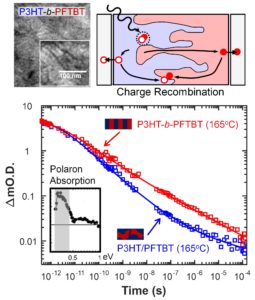The founders of Magnitude Instruments discuss how advances in noise suppression technology are enabling new frontiers in nanosecond transient absorption spectroscopy applied to operating photovoltaic, catalytic, and biochemical systems.
Advances in Noise Suppression Technology – Doing More with ns-TA
Table of Contents
ABSTRACT: Recent innovations in noise suppression technology from Magnitude Instruments have enabled orders of magnitude enhancement in the sensitivity of transient absorption (TA) spectroscopy. Here we show how the sensitivity enabled TA measurements of halide perovskite photovoltaics with photogenerated carrier densities that matched the operating conditions of solar cells and provided new insight about the electronic and transport properties of these remarkable materials.: Investigators in photovoltaic and photocatalysis research measure electronic processes on both ultrafast and nanosecond-millisecond time scales using transient absorption (TA) spectroscopy. A common approach was to use ultrafast detection equipment for both time scales. Today, new noise suppression technology allows nanosecond-millisecond measurements with 100-fold higher sensitivity that enables in-situ and operando studies that were previously inaccessible.
In the past, a common approach to make transient absorption measurements on ultrafast and nanosecond-millisecond time scales was to use the same ultrafast laser sources and detection equipment for both time scales. This approach made it easy to conduct the measurements under identical conditions. Today, new patent-pending noise suppression technology (NST) enables 100-fold enhancements in the speed and sensitivity of nanosecond time scale transient absorption measurements. NST detection also makes it possible to measure and subtract the electronic artifacts that obscure transient signals in traditional nanosecond experiments. This enables collection of the entire time axis directly from the detector response with each laser shot, which dramatically accelerates the measurement and enhances its accuracy. Other methods rely on gated integrators or lock-in amplifiers to remove electronic noise at the cost of sacrificing the time axis and slowing the experiment.
The development of NST detection is transformative because the 100-fold enhancement in sensitivity enables transient absorption spectroscopy in new types of measurements that were previously inaccessible. For example, in situ and operando measurements of low concentration chemical intermediates or surface adsorbed species that form on catalysts in functional electrochemical, photochemical, or catalytic systems can now be identified and time-resolved under operating conditions to guide catalyst/materials development. The ability to measure nanosecond transient absorption kinetics in seconds rather than hours makes it possible to integrate high throughput measurements of chemical intermediates and excited state lifetimes into synthetic chemistry and device development workflows for structure/property/performance correlations. These advances help close the loop between fundamental research and practical applications.
These advances cannot be achieved using traditional approaches that rely on the same laser sources and detection equipment for ultrafast and nanosecond-millisecond time scale measurements. Additionally, the gated integrators or lock-in amplifiers that were needed to remove electronic noise from such traditional measurements erase the time axis from the detector response, and thus take orders of magnitude longer to acquire the time axis in transient measurements. Adaptation of NST detection in Magnitude’s instruments overcomes this problem. Capitalizing on the new capabilities that come from NST detection does involve using separate detection equipment for ultrafast and nanosecond time scale measurements. However, connection of the time scales is straightforward and easily achieved by matching the excitation density conditions in both experiments. The transient absorption data in Figure 1 showing charge recombination kinetics measured in a high performance P3HT-b-PFTBT block copolymer organic photovoltaic (OPV) film1 demonstrate this ability.

Figure 1. Mid-infrared transient absorption kinetics traces of charge carriers photogenerated in P3HT-b-PFTBT and P3HT/PFTBT OPV blend films measured on ultrafast and nanosecond-millisecond time scales. The ability to track charge re-combination kinetics over nine orders of magnitude revealed the concept of molecular rectification that underpinned the high performance of this system. Adapted from Ref. 1.
ACKNOWLEDGMENT
We are grateful to Enrique D. Gomez for the TEM image in Figure 1.
REFERENCES
- Grieco et al. JPCC (2016) DOI: 10.1021/acs.jpcc.6b00103.

SHARE